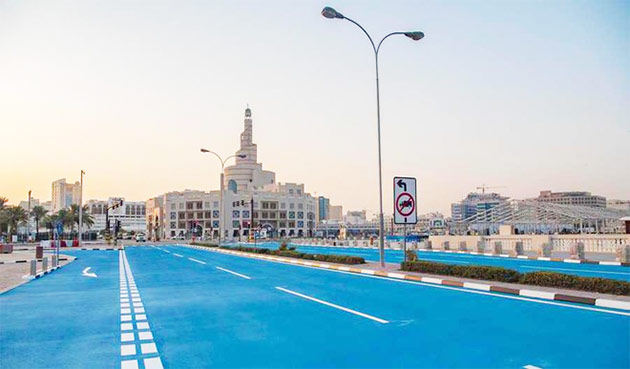Qatar has turned a busy stretch of road into bright blue as part of an experiment to cool the tarmac surface and reduce the temperature of surrounding areas.
The temperatures in desert emirate can touch as high as 50 degree Celsius, and heat was a major concern when Qatar was named as host for 2022 World Cup.
Although the tournament will be hosted in the winter months when the temperature would cooler, Doha still grapples with stiff conditions this summer.

High temperatures can lead to cracks in car dashboards, discolouring of paintworks and melting of plastic trim, thereby encouraging authorities to look for innovative solutions. Therefore, a 200m stretch of downtown thoroughfare leading to waterfront has been coated with one millimetre thick blue heat-reflective pigment.
During an 18-month trial period, Ashghal, the public works authority will test if the new surface can effectively bring down the temperature and reduce heat in the area around the coated road.
The head of sustainability at the Qatar Green Building Council, Alex Amato said that we do have an environment where there are higher temperatures that occur in the surrounding hinterland, and that may be uncomfortable. Therefore, instead of having a black road that greatly absorbs heat, this road may reflect some of the heat away, he explained.
Similar cool paving schemes were already trialled in few other places including Los Angeles.
Japan, which usually sees intense heat and humidity during the summer, is hosting several high-profile sporting events including Rugby World Cup this year, and the 2020 Summer Olympics.
Authorities in the Capital city have agreed to install reflective road surfaces across the capital too, to combat high temperatures. The city will also plant shrubs to absorb heat through a natural process of photosynthesis.
Both tarmac and cement absorbs solar energy during the day and releases it during the night, and hence, cities are usually hotter than the surrounding countryside as buildings and streets act as a giant heat sink.
It is now hoped that Doha’s blue roads will absorbs less solar radiation and reflect UV rays, thereby reducing the local temperature for passing pedestrians and motorists.
A digital display alongside the Doha experiment indicated that traditional surface was between 6 to 10 degrees hotter than covered roadway.
Although the external temperature cannot be alleviated completely, we can certainly extend that period when people can use those external spaces, Amato said.
Refer Qatar climate and weather conditions here.